The Chornobyl Exclusion Zone: Polesia’s complex legacy
Polesia is known as a vast area of rich and diverse wilderness, however, not everyone realises that it was this very land that experienced one of the worst ecological disasters in history. It is Polesia that hosts the Chornobyl Exclusion Zone – the abandoned area created as a result of the sadly remembered nuclear accident. The complicated processes that have been taking place there for almost four decades, including the unguided rewilding of the abandoned areas and the lasting impact of radioactive contamination, continue to attract the attention of scientists and conservationists.
On 26 April 1986, a terrible accident occurred at the Chornobyl Nuclear Power Plant. As a result of an explosion, one of the nuclear units was destroyed. This led to the release of radioactive contaminants that quickly spread across the territories of the former Soviet Union and Europe. More than 115,000 people had to leave their homes in the 470,000-hectare area around the plant because of the severe contamination. This still uninhabited area, known as the Chornobyl Exclusion Zone (CEZ), is shared by Ukraine and Belarus. It is unevenly contaminated with radionuclides, including strontium, caesium, aluminium and plutonium, while many other radionuclides have already decayed. A special concrete confinement was built over the destroyed nuclear unit of the power plant to prevent further leakage of radioactive material.
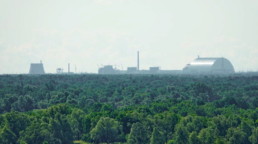
In 1988, the Polesia State Radioecological Reserve was founded in the Belarusian part of the CEZ. In 2016, the Chornobyl Radiation and Ecological Biosphere Reserve was established in Ukraine. These scientific and conservation institutions carry out research work and monitoring of wildlife in the territory of the Exclusion Zone.
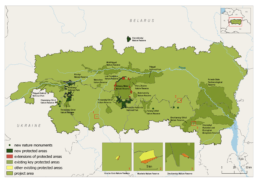
In the immediate aftermath of the accident, local wildlife was exposed to extremely high levels of radiation. This had a devastating effect on vegetation and wildlife, especially in the immediate vicinity of the destroyed reactor. Today, however, most of the CEZ has nothing in common with a nuclear desert. In fact, under conditions of almost total absence of anthropogenic pressure, wilderness has begun to reclaim areas that were once densely populated and intensively used for agricultural purposes. For instance, censuses have shown that red deer, roe deer, elk, and wild boar are increasing in the abandoned areas. The introduced Przewalski’s horses and European bison formed stable and growing populations. According to the same research, the number of grey wolves in the CEZ is several times higher than in some uncontaminated nature reserves in Belarus. Other research supported by our project showed that the Eurasian lynx density in the CEZ is significantly higher than in some other protected areas. Remarkably, camera traps deployed in the Chornobyl Radiation and Ecological Biosphere Reserve have detected the presence of brown bears in the Exclusion Zone.
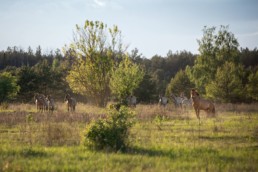
In the 20th century, the once swampy areas of today’s CEZ were heavily drained for agricultural purposes. Soon after the accident, numerous drainage canals in the Belarusian part of the CEZ were blocked to prevent wildfires and the discharge of contaminated water. And the landscape started to change: mires and forests are gradually replacing farmland. Subsequently, the species’ composition has changed, too. For example, the abundance of bird species dependent on humans or transformed landscapes decreased, while the globally endangered Greater spotted eagle is recolonising the CEZ. These predators, which depend on intact wetlands and are extremely sensitive to human disturbance during nesting, seem to have found ideal habitat here.
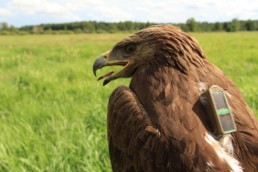
At the same time, some scientists are warning their colleagues against undue optimism and calling for other aspects of the problem to be considered. Some studies show negative long-term effects of low-level radiation on several generations of mammals. Others point out that some bird species have shown a tendency towards more frequent genetic mutations and reproductive difficulties in areas with relatively high levels of contamination. The abundance of various species – from soil invertebrates to mammals – is reported to have decreased in such areas. At the same time, opponents insist that radiation as such is not the only possible explanation for the observed adverse effects. The heated debate continues, but it’s clear that many aspects of post-Chornobyl biology remain to be studied.
The Russian military invasion of Ukraine in 2022 seriously disrupted research work in the CEZ. At the very beginning of the war, Russian troops occupied the Chornobyl Nuclear Power Plant and the adjacent areas of the Chornobyl Radiation and Ecological Biosphere Reserve. As a result, the reserve’s property and equipment were damaged or destroyed, and the area is still mined. This makes any field work extremely difficult and dangerous. And yet, despite all the difficulties, activities in the CEZ haven’t stopped completely. The staff continue to carry out radiological and wildlife monitoring and are working to prevent the spread of radionuclides from the contaminated areas.
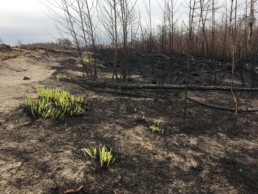
One of the most serious problems in the Ukrainian part of the CEZ at the moment is wildfires. Unlike the Belarusian part of the zone, the Ukrainian one has been heavily drained to prevent the spread of contamination by water flow. However, the result has been detrimental: frequent fires now cause severe air pollution and radioactive emissions. In 2020, 5% of the area was affected by flames. Fortunately, firefighters were able to prevent the radioactive waste dump from catching fire that year. Scientists emphasise that restoration of drained and disturbed wetlands is the most efficient nature-based solution to the problem of landscape fires. Large-scale wetland restoration in the Ukrainian CEZ is currently impossible. However, a site in this part of Polesia is among five areas selected for rewetting as part of our project. We hope to equip the reserve’s staff with the skills and knowledge needed to expand restoration in the future.
The Chornobyl Exclusion Zone is a unique area in Polesia, where the unintentional ecological experiment has been going on for almost 40 years and is unlikely to end in the foreseeable future. Paid for with the lives and health of thousands of people, numerous personal tragedies and harmful ecological consequences, it gives us a rare opportunity to gain valuable knowledge and reflect on the role of humankind in the environment of our planet.
The project “Polesia – Wilderness Without Borders” is part of the Endangered Landscapes & Seascapes Programme and is funded by Arcadia. The project is coordinated by Frankfurt Zoological Society (FZS).




